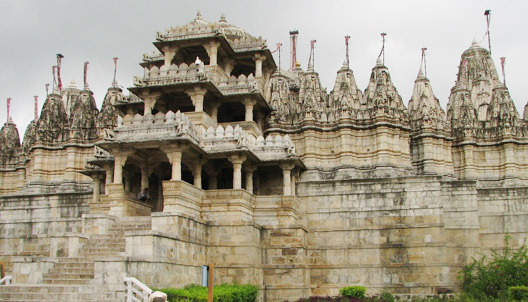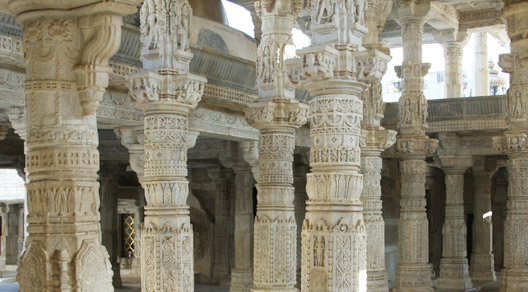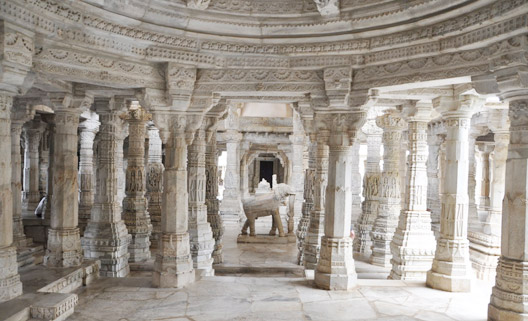The Jain temple at Ranakpur is a slice of heaven relocated on earth. This architectural marvel is as delicate as finely embroidered lace yet as imposing and complex in design as it is profoundly logical.

As you stand before a single pillar, you realise that it is very different from the other 419 that supported this divine creation. While no two pillars in this lavishly carved temple are the same, this particular one was unique in a very special way - it was distinctly crooked. No, it was not the light playing tricks. It was intentionally built that way.
Every human being must remember that nothing is perfect..there is always something that needs attention in order to get closer to God..or excellence. Tucked away in the forests of Aravali hills, the 15th centuary temple, 60 Kms from Udaipur, sits elegantly poised on the banks of the Maghai River. The open courtyard outside the temple complex is uncluttered and free of stalls and vendors. Here one gets the space to admire the outer shell of the temple; its soaring central roof capping divinity as it poured down from the heavens to take concrete form on contact with earth.
The structure is huge and stood on a massive elevated plinth measuring 45,000 sq ft. The moment one enters the temple doors, he is immediately awestruck by the scale and audacity of its design. It is like witnessing a bewildering maze where shafts of light sliced through corridors of carved pillars and sprayed their warmth into the cups of ornate domes overhead. You get engulfed in a world of celestial maidens and playful nymphs that clung to the ceilings, walls and pillars and celebrated the divinity of the Jain saints, or Tirthankaras, enshrined in the temple.

Slowly the scheme of Ranakpur starts to unravel. It was designed as a chakra, or wheel, with four spokes radiating out of the central altar. It comprised five spires, 20 domes, 29 halls and 420 pillars. Almost every inch of material used in its construction was alive with lavish and delicate carvings. No two pillars were alike. So too the overhead domes that seemed to hinge around ornate central pendants. The ingenuity of the layout was such that the entire structure was bathed in natural light that streamed in from the courtyards within the temple that opened out to the sky.
Tucked into nooks and crevices of the temple were fine etchings with depicted scenes from the scriptures. The most striking of these was a circular image of memerising patterns that portrays the story of Parshava. According to a legend, Prince Parshva was out exploring his kingdom when he came upon a ascetic performing the fire penance. Gifted with divine insight he realised that a snake lay trapped within one of the logs in the fire. Overcome by pity, he barged in on the ceremony and split the log open with an axe and set the hapless snake free.
This naturally offended the ascetic deeply and though he was reborn a celestial being in his next life ( the fruits of much penance ) he still carried a grudge against Parshava. One day while riding across the sky, he spied the prince engaged in penance and decided to rain on his parade. Summoning up a great storm he planned to drown his nemesis. Meanwhile the snake that had survived the ascetic's fire was reborn as the lord of Nagas. Seeing the peril Parshava was in, he rushed in to repay a debt of gratitude. First he coiled his body around his savior and lifted him above the rising water and then spread his thousand-headed hood protectively over the prince.
One intriguing little panel depicts two men who, according to local belief, represent Dharnasah, the man who built the temple and Depa, the sculptor who designed it.
Dharnasah was a wealthy Jain and a prominent minister in the court of Rana Kumbha, the ruler of Mewar. One day Dharnasah had a dream about the clestial vehicle used by heavenly beings. He awoke the following morning with a burning determination to give expression to his vision in the form of a temple. The king was delighted by the concept and assisted Dharnasah by granting him a plot of land on the banks of Maghai River. His one condition however, was that the place be named after him.

In 1394 Dharnasah began his long and frustating search for the man who would transform his dream into stone. After many fruitless years he summoned up the courage to approach Depa, an eccentric recluse. Depa silently heard out Dharnash's brief and slipped into a deep meditation. A few days later he produced a drawing that seemed to be stolen from heaven itself. Thousands of sculptures and craftsman laboured for almost 50 years on the creation which was eventually consecrated in 1439 and dedicated to Lord Adinath.
For two centuries, it was a beacon of devotion before it fell upon lean times. Around the 17th century, the entire region was ravaged by war. Fearing that the statues would be desecrated, the pujaris hid them in cellars under the temple and fled the area. The invading forces vandalized the temple. Time and the elements ravaged what they did not touch. Shunned and neglected, Ranakpur became a refuge for decoits. Pilgrims only dared to venture here arround the first quarter of the 20th century when the area was purged of outlaws and the temple restored to its former glory.
Across the compound is a tight cluster of smaller temples that merit only a cursory visit as they pale in comparison to the main structure.
In order to give more time to appreciate this structure of beauty and devotion, one can check in at Maharani Bagh, a hunting lodge of the Maharajas of Jodhpur, now converted into a peaceful retreat for tourists. You may I stretch yourself in the verandah of a charming little cottage and gaze out at rolling forested hills that melt into a hazy horizon. All around you the air is filled with the call of exotic birds and the gurgle of water in the irrigation canal that runs through close by.
As the light of day starts to fade, we returned to the temple to participating in an arti that is performed here every evening after sundown. A row of small divas or lamps lit the way from the entrance to the central shrine. The temple priest prepared for the ritual as a lone nun knelt in front of the main deity, whose glinting eyes reflected the flickering flames around it. The tensions and strife of the outside world melted away and we were sucked into the all-encompassing embrace of peace and well being in the universe.
You can stay here for thousands of years..and yet feel thirsty for the pleasures of excellence and devotion in these hills of Arawali.